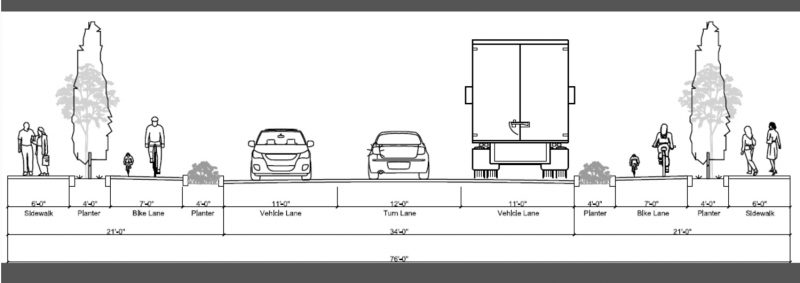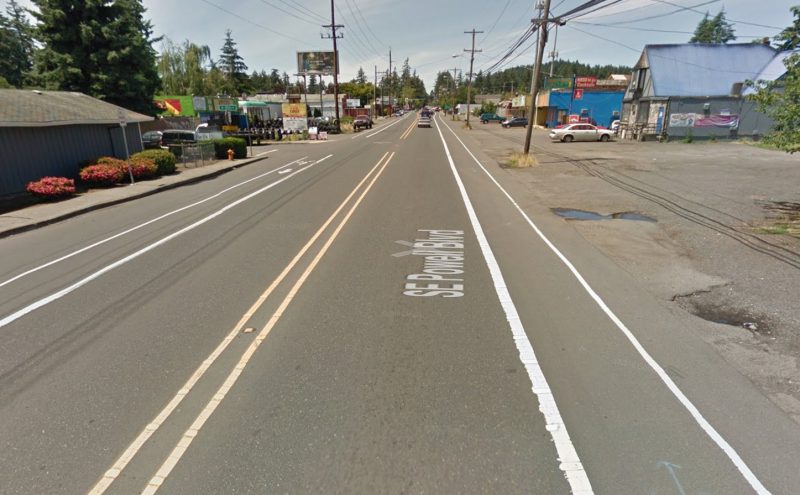
18 months of debate about how to provide safe bike access on a 14-block stretch of Southeast Powell Boulevard is finally coming to an end. At least the Oregon Department of Transportation hopes it is.
Saying they are now months behind schedule, ODOT wants to move forward into the final design stage of a project that will rebuild Powell between SE 122nd and 136th. With $17 million from the State Legislature and another $3 million from Metro, the latest incarnation of ODOT’s Outer Powell Safety Project will add a host of updates to this state highway (U.S. Route 26), which has one of the worst crash records of any road in Oregon. This project will bring long-awaited changes and additions to signals, sidewalks, intersections, landscaping, crosswalks, and bike lanes.

It’s those bike lanes that have been the sticking point: ODOT, project advisory committee members, east Portland neighborhood advocates, and the City of Portland all have different ideas about what type of bike facility should be implemented. Where ODOT sees a state highway with 20,000 cars per day passing though, the Portland Bureau of Transportation (PBOT) sees a once-in-a-lifetime opportunity to create a high-quality biking and walking environment that will help east Portland grow in a much safer, healthier and more efficient way. And residents who live in this area just want a street they can use and cross without fear of being killed.
For months now, the East Portland Action Plan (EPAP, a City of Portland funded neighborhood group) has been a thorn in ODOT’s side in an effort to push the agency further on the bicycle facility. I rolled out to their meeting at David Douglas High School last week to learn the latest.

(Photo: J. Maus/BikePortland)
At the EPAP meeting on Wednesday, ODOT announced they plan to implement their first-ever physically protected bike lane on a state highway. ODOT also says they’ll consider a “potential” raised cycle track for a short segment of the street — something that will require formal design exceptions to be granted by the state traffic engineer and something EPAP’s representative on the project doesn’t even trust ODOT to actually follow through on.
ODOT’s Region 1 Transit and Active Transportation Liaison Jessica Horning was at the meeting to clarify the agency’s intentions. She brought with her two sets of white, plastic “Tuff-Curbs” with vertical delineator posts attached to them. Horning said ODOT’s plan is to use this product to create physical separation in the two-foot buffer zone that will separate the six-foot bike lane from motor vehicle traffic. “This is going to be our first physically separated bike lane on an ODOT facility in the state,” she told me after the meeting.
This section of Powell currently has one standard lane and one bike-only lane in each direction — and lacks complete sidewalks. A major safety concern is how people drive into the bike lane in order to swerve around other drivers who stop to make turns. The center turn lane and plastic posts and curbs separating the bike lane will hopefully end that behavior. Take a look at the proposed cross-section below and keep in mind it doesn’t show the plastic curbs or the concrete that will be used for the bike lane in order to make it stand out visually:
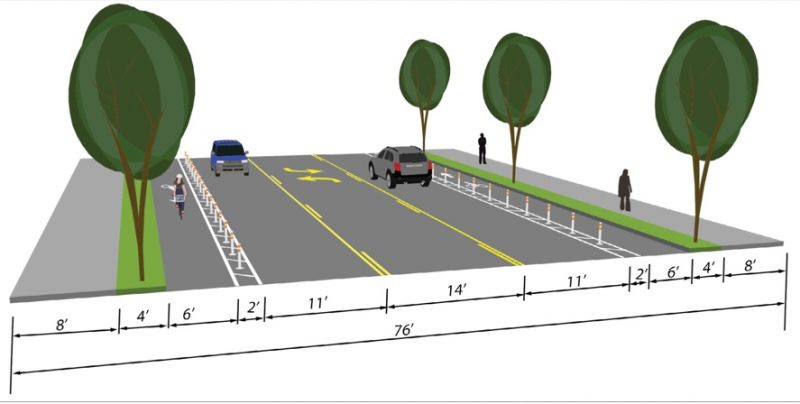
And here’s the new traffic signal ODOT will install at the intersection with 122nd to prevent right-hooks:

There’s no guarantee it will happen, but here’s what ODOT is considering as a pilot project between 132nd and 136th:
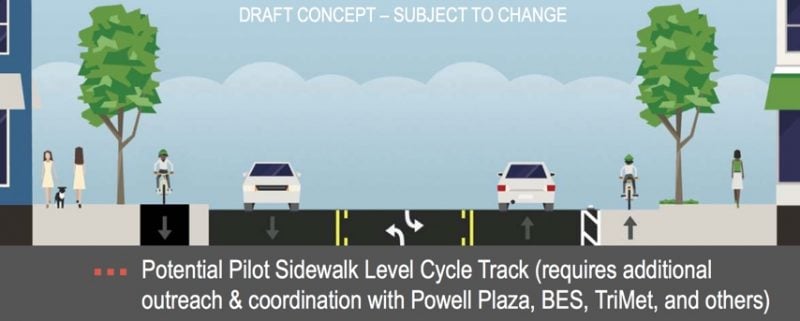
Horning feels this is a big step for ODOT. “When you think about our standard treatment for a highway like Powell, if you just look at the [design guideline] books, it’s a six-foot bike lane and six-foot curb-tight sidewalk and we’re going to have an eight-foot buffered bike lane with physical separation that’s a different material than the pavement itself, a landscape strip with stormwater treatment, and a sidewalk. I’m excited about that.”
Some advocates and the City of Portland don’t share her enthusiasm. While eager for any safety improvements to Powell after fighting decades for changes, they want ODOT to get it right the first time.

Jim Chasse, who lives near 116th and Powell and rides on the street almost daily, has advocated for safety on the street for nearly 20 years (we profiled him in 2014). “The neighborhood’s position is, we just want it fixed,” he told me in a phone interview last night. “Fixed to the best standards we can get. We told ODOT, we’re willing to work with you, but you need to be willing to work with us.”
Chasse is also concerned about how hundreds of white plastic posts and curbs will look. “We want something that’s aesthetically pleasing. It’s our neighborhood. To have these reflective wands going down the street… It may be safer, but how would you feel about looking at those things day-in and day-out? I’m OK with them but I’m not a big proponent.”
From ODOT’s perspective, they have worked with EPAP. The vertical posts and potential cycle track plans go further than the agency initially wanted to go. When the project began in July 2015 only buffered bike lanes — with no physical separation — were on the table. But that didn’t sit well with advocates or with the City of Portland. Advocates wanted raised bike lanes/cycle tracks that would be at sidewalk level (similar to ones on SW Multnomah and NE Cully) and they were optimistic that ODOT was at least receptive to the idea. A year later however, ODOT nixed the raised lane idea. After analyzing the design, state traffic engineers felt it would be too challenging. They cited potential issues with stormwater drainage, freight truck movement, the over 300 driveways in the corridor that would interfere with it, and the difficulty of sweeping the relatively narrow lanes. And on the north side of the street, ODOT said any type of raised bike lanes would be out of the question because of a 52-inch, 100-year old water pipe that sits just three feet below the surface.
“Each [one of these issues] on their own wasn’t a dealbreaker,” ODOT’s regional engineer on the project told us in July 2016, “but taken in aggregate [a raised bike lane] presents a long list of challenges.”
While ODOT was able to convince their official project advisory committee that buffered bike lanes would suffice, advocates with EPAP were not satisfied. EPAP vowed to continue fighting for more significant physical separation between bicycle and car users — especially on the south side of the street where there’s no issue with an old water pipe. EPAP wanted to know: If ODOT is willing to consider a cycle-track on four blocks on the south side of the street, why not do it on the entire stretch?
Because of EPAP’s persistent advocacy, ODOT decided to pause the project and work with them and the City of Portland to try and find a bikeway treatment that would satisfy everyone. By last fall, ODOT made some progress, but not everyone was on the same page.
Advertisement
At their October Bicycle Advisory Committee (BAC) meeting, PBOT made a rare move to influence the project: After ODOT shared their plans, PBOT stepped up and shared theirs. Keep in mind, this is ODOT’s road and ODOT’s project; it was an extraordinary step for PBOT to present a dueling design at this late stage of the project. It was clear that PBOT was frustrated. They felt ODOT was not trying hard enough to create a bike facility that would attract “interested but concerned” riders.
Powell might be ODOT’s road, but the goal of 25 percent bicycle mode share by 2030 — officially adopted by City Council in the Climate Action Plan — is squarely on PBOT’s shoulders.
Instead of the six-foot bike lane and two-foot buffer in ODOT’s plans, PBOT traffic engineer Lewis Wardrip presented a plan for seven-foot wide raised cycle-tracks on both sides of Powell that would be separated from motorized traffic by a four-foot planting strip. Here’s PBOT’s cross-section:

Wardrip also presented a list of “design elements” they’d like to see on the project. They included: a speed limit of 30 mph (instead of 35); the use of button-activated hybrid traffic signals (aka “HAWK” signals) instead of flashing beacons; keep the bikeway at sidewalk elevation at all driveways (ODOT assumes a raised lane would have to dip down, then go back up at each driveway); and maintain raised crosswalks and bikeway at local streets.
“How people move through a space is more important than how water moves through a space. We’re here to tell you to push the envelope further.”
— Ian Stude, chair of the City of Portland Bicycle Advisory Committee
In response, ODOT said the type of bike facility PBOT wants is simply not possible right now. At that October BAC meeting, ODOT project manager Mike Mason said the water pipe under the north side of the street is too big of a challenge to deal with. Upon hearing those concerns, BAC Chair Ian Stude said, “How people move through a space is more important than how water moves through a space. We’re here to tell you to push the envelope further.”
That was October. Between then and now, ODOT has decided to keep their plans essentially the same. In addition to what they feel are myriad technical challenges with a more robust bike facility, they are feeling pressure to finalize the decision. In June 2016, four months prior to the BAC meeting with PBOT, ODOT Interim Area Manager Shelli Romero (according to meeting minutes) told the project’s advisory committee that, “This is a critical time for the project to move forward and not be delayed… If it doesn’t continue to move forward now it can threaten the project and timeline.”
Now six months later, EPAP is still uneasy with ODOT’s plans.
“We’ve now spent two years reviewing and reconsidering the bike improvement options for Outer Powell… ODOT has given the design team the go ahead to move quickly.”
— Rian Windsheimer, director of ODOT Region 1
In November, EPAP sent a letter (PDF) with a list of demands to ODOT Region 1 Manager Rian Windsheimer, (former) PBOT Commissioner Steve Novick, and PBOT Director Leah Treat. The letter was signed by five Oregon State Representatives, former Bicycle Transportation Alliance (now The Street Trust) Executive Director Rob Sadowsky, and six representatives of the East Portland Action Plan.
In that letter EPAP said they understand the limitations presented by the water pipe on the north side of the street and they’d be willing to support the buffered bike lane with vertical delineation. Beyond that, they demanded the same things PBOT presented at the BAC meeting a month prior: a cycle-track treatment for the entire length of the project on the south side of the street; hybrid “HAWK” traffic signals instead of flashing beacons; a speed limit reduction to 30 mph; and a bike-only signal at Powell and 136th to prevent right-hook collisions.
“After careful review of the proposed update to the Transportation System Plan and the Bicycle Plan for 2030, as well as discussions with PBOT staff, we feel that the current proposed buffered or tuff curb design does not meet the City’s goal to design facilities that will attract all ages and abilities, nor does it utilize best practice design that is suitable for main arterials in Portland.”
— from a joint letter to ODOT Region 1 Director signed by the Portland Bicycle Advisory Committee and Pedestrian Advisory Committee
It took ODOT nine weeks to reply (a fact that has frustrated EPAP, given the timeline concerns expressed by ODOT staff). In his January 18th letter in response (PDF), Windsheimer thanked EPAP for their advocacy and support, but made clear his intention to move on. “We’ve now spent two years reviewing and reconsidering the bike improvement options for Outer Powell… Now, having reached a decision for moving ahead on the bike treatment, which was the only outstanding element from the decision committee’s recommendation back in 2015, ODOT has given the design team the go-ahead to move quickly…”
Windsheimer also addressed each of EPAP’s outstanding demands.
He said ODOT won’t consider the pilot cycle-track beyond the four-block segment. “Due to the large number of driveways, side streets, and service vehicle conflicts in the remainder of the project area,” he wrote, “we feel the ‘Tuff Curb’ is a more compatible solution.” (Region 1 planner Jessica Horning explained ODOT’s rationale for the small segment like this in an email yesterday: “We want to try out the cycle track design on a smaller segment where the conditions are most conducive first so that we can make sure that it operates/looks/feels the way that everyone wants it to before we start trying to adapt the design to more challenging/constrained segments of Powell.”)
Windsheimer also denied the request to install HAWK signals instead of flashing beacons and medians, citing high motor vehicle user compliance with existing beacons on other ODOT highways.
As for the speed reduction request, Windsheimer said the right time to consider that would be after the project is complete to see if the new cross-section results in slower speeds (speeds are set by a Speed Review Panel that takes into account current speeds in setting new ones). And finally, Windsheimer said ODOT won’t install a bike-only signal at 136th because of space constraints. They’ll look to use signage instead. (ODOT does however, plan to install a bike-only signal at 122nd.)
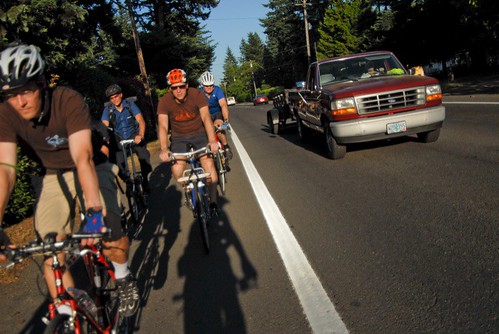
(Photo: J. Maus/BikePortland)
While ODOT marches forward, representatives from EPAP aren’t satisfied. They want a meeting with Windsheimer to hear further clarifications about why ODOT is unwilling to extend the south-side cycle-track. They also want to know more about the underground water pipe concerns ODOT has on the north side of the street. “I do think we need some answers about the stormwater system,” EPAP’s representative Jim Chasse said Wednesday night, “And we think the south side of Powell would be a good place for a complete raised facility. If we don’t get it right here, it’s going to reflect on the rest of the corridor.”
—
Chasse’s comments were echoed by EPAP Co-chair Arlene Kimura. “If you’re going to ask for an [design] exception for four blocks, why not go the whole mile?”
And it’s worth noting that ODOT hasn’t promised the cycle track pilot will happen at all. It’s listed as “potential” in their presentations. Asked whether he felt the four-block cycle track pilot would actually become a reality, Chasse didn’t mince words. “No, I think that was thrown in as bait,” he said. Chasse has every reason to be cynical. ODOT dangled the potential of physically separated bike lanes on outer Powell in front of advocates in 2012 — only to build conventional five-foot bike lanes in the end.
The City of Portland’s Bicycle Advisory Committee isn’t satisfied either. In a November 16th letter (PDF) — which was co-signed by the City’s Pedestrian Advisory Committee — they said, “After careful review of the proposed update to the Transportation System Plan and the Bicycle Plan for 2030, as well as discussions with PBOT staff, we feel that the current proposed buffered or tuff curb design does not meet the City’s goal to design facilities that will attract all ages and abilities, nor does it utilize best practice design that is suitable for main arterials in Portland.”
For their part, ODOT isn’t closing the door to debate completely yet. Horning says they’ll still be open to discussions about minor design details, but she feels the agency is set to move forward. “There will be more opportunities for discussion,” she wrote in an email yesterday. “I think we are headed in a really good direction and that this project is going to be a game changer for this section of Powell Blvd. I’m very excited to be moving forward with design of ODOT’s first separated bikeway.”
The project is slated to begin construction at the end of 2018 and be completed in 2019. You can contact ODOT with your thoughts about this project at OuterPowellSafety.org
— Jonathan Maus: (503) 706-8804, @jonathan_maus on Twitter and jonathan@bikeportland.org
BikePortland is supported by the community (that means you!). Please become a subscriber or make a donation today.

